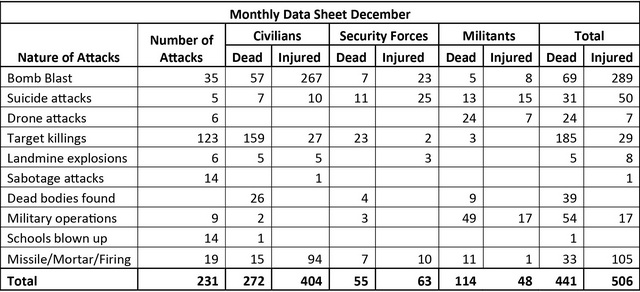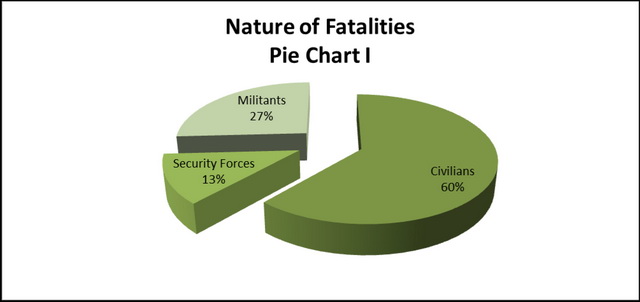The raging wave of violence surged significantly during December across Pakistan. Ethno-political violence in Karachi, religio-terrorism in Federally Administered Tribal Areas (FATA) and Khyber Pakhtunkhwa (KP), and nationalist-separatist violence in Balochistan meanwhile continued unabated. The deadly wave of target killing in Karachi, started in the last week of March, continue to mount death toll during December. The deadly wave left almost 121 persons dead (due to target killing) during the current month. In total, 139 persons perished in Karachi during December in different circumstances. The data collected throughten newspapers, that CRSS uses as the source, suggests that some 441 people lost their lives in 231 incidents of violence across the country (for details see data sheet). The violent clashes also left 506 people injured in December.
Concise look into the casualty figures underlines that the civilians remained the major target of violent actors, with the civilians accounting major loss of lives as a result of various acts of violence and terror in Pakistan. As noted in pie chart I below, civilians were 60 percent of the total dead in December. The share of the civilian deaths is lower than the previous month, wherein 74 percent of the dead were innocent civilians. As a whole, 272 civilians were killed in different circumstances during the month. Moreover, the data suggests that the militants fighting against the state remained the second major target i.e. 27 percent (114) of the total dead. Clashes also left 55 security forces– personnel (13 percent of total deaths) dead and these were mostly recorded in insurgency infested areas of FATA, Karachi and Balochistan. Furthermore, during December (from 30 November to 03 January), six CIA operated drone strike were reported in different areas of North Waziristan Agency (FATA), leaving as many as 24 suspected militants dead. Between March 2012 and January 03, 2013, 42 drone attacks have killed almost 295 suspected militants. Meanwhile, continuing their sabotage campaign to demolish state infrastructure, militants blew up 14 state run schools and 14 other sort of infrastructure in different parts of FATA and KP during the course of month.
In December, target killing was the major cause of deaths. Pie chart II below shows that 52 percent of all the violent incidents were of target killing in nature, accounting for 42 percent of the total death toll. Numerically, 185 persons were shot dead across Pakistan, as a result of 123 incidents of target killing. Karachi witnessed the major loss of lives as a result of target killing, wherein 121 persons (65 percent of the total dead in target killings, while 27 percent of the total death toll) were assassinated during the month. Meanwhile, bomb blasts carried out by the militants were the second major cause of deaths. As a result of which, as many as 69 persons perished, including 57 civilians and five militants and seven security forces personnel in different parts of the country. Meanwhile, in December, 39 dead bodies were also recovered from different parts of Pakistan, most of them were found in Karachi, Peshawar, FATA and Balochistan. The third major cause of the violence was military operations. In total, 54 persons including 49 militants and three forces– personnel perished in this form of attacks. Likewise, five suicide attacks left 31 persons dead and another 50 injured in different areas of the country.
A peer into the territory and intensity of violence underlines that Sindh witnessed major loss of lives during the current month, wherein almost 144 persons were butchered during December (as shown in bar chart below). After Sindh, FATA turned out to be the second major hub of violence, where religious terrorism left almost 90 people dead during the current month. Meanwhile, violence across Balochistan and KP subsided significantly during the course of the month.
Moreover, the sporadic waves of sectarian violence continued to pile up misery in Pakistan. In December, 55 people (seven percent of all the dead) were killed and 25 others got injured in sectarian attacks; majority belonging to Shia minority sect, in different areas of Balochistan, Sindh, KP and Punjab as a result of 15 violent incidents. Of the total 15 attacks, 14 attacks that is, 93 percent took place in Karachi alone killing 65 percent (36) of the total dead in sectarian violence. Latest trends in sectarian violence across Pakistan underscore the fact that this sort of violence is on the rise, once again. Shia sect people based in Quetta and Karachi were among the frequent targets of sectarian terrorists.
Meanwhile, data relating to the nature of violence suggests that almost 57 percent of the total loss of life was the direct consequence of religio-terrorism. The epicenter of faith-based violence continues to be FATA and KP. Ethno-political violence involving political parties, meanwhile, led to the decimation of 57 percent of the total dead. While both nationalist-separatist violence in Balochistan and sectarian violence across Pakistan accounted for almost 19 percent of the total fatalities. Accumulative data of last three months (September-December) shows that 1823 persons have perished across Pakistan as a result of the ongoing wave of violence. Among these, October was the most violent month, wherein large numbers of deaths occurred due to the clashes between military and militants and spree of target killings in FATA, KP and Karachi.
A peer into the trends and territory of violence across the country underlines that the fragility of law and order situation across Pakistan persists. Meanwhile in December, sectarian violence across Pakistan was on the rise. Karachi and Quetta, the two cities where multiple actors are involved in infighting, have created vacuum in recent months for sectarian terrorists and they are fully preying upon sectarian minorities there, especially Shia.
Sources
- The News
- Dawn
- The Express Tribune
- Pakistan Today
- Daily Times
- The Frontier Post
- Jang (Urdu)
- Daily Mashriq (Urdu)
- Aaj (Urdu)
- The Nation





